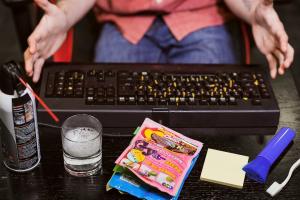Ultimate Guide: How to Clean Your Computer Keyboard Like a Pro

-
Quick Links:
- Introduction
- Why Clean Your Keyboard?
- Tools Needed for Cleaning
- Step-by-Step Guide to Clean Your Keyboard
- Deep Cleaning Techniques
- Cleaning Different Types of Keyboards
- Maintenance Tips for Your Keyboard
- Case Studies and Expert Insights
- FAQs
Introduction
Computer keyboards are essential tools that endure daily wear and tear. From crumbs to dust, they attract a plethora of debris that can not only affect their performance but also harbor harmful bacteria. This guide will walk you through the best methods to clean your keyboard efficiently, ensuring it remains a productive tool in your workspace.
Why Clean Your Keyboard?
Cleaning your keyboard is crucial for several reasons:
- Hygiene: Keyboards can be breeding grounds for germs and bacteria.
- Performance: Dirt and debris can hinder key responsiveness.
- Longevity: Regular maintenance can extend the life of your keyboard.
- Aesthetics: A clean keyboard looks better and feels good to use.
Tools Needed for Cleaning
Before starting, gather the following tools:
- Compressed air canister
- Microfiber cloth
- Isopropyl alcohol (70% or higher)
- Cotton swabs
- Soft brush (e.g., paintbrush)
- Small bowl of soapy water (optional)
Step-by-Step Guide to Clean Your Keyboard
Follow these steps for a thorough keyboard cleaning:
1. Prepare Your Workspace
Clear your desk area and gather your cleaning tools. Make sure to unplug your keyboard or turn off your laptop.
2. Shake and Tap
Hold the keyboard upside down and gently shake it to dislodge loose debris. You can also tap it lightly against a soft surface.
3. Use Compressed Air
Utilize the compressed air canister to blow away dust and crumbs from between the keys. Keep the canister upright and use short bursts.
4. Wipe Down the Surface
Moisten a microfiber cloth with isopropyl alcohol and wipe the surface of the keys and the keyboard frame. Make sure the cloth is not dripping wet.
5. Clean the Gaps
Use cotton swabs dipped in isopropyl alcohol to clean around the edges of the keys and in tight spaces.
6. Let It Dry
Allow your keyboard to dry completely before plugging it back in or turning it on.
Deep Cleaning Techniques
If your keyboard is particularly dirty, consider these additional steps:
1. Keycap Removal
For mechanical keyboards, you can remove the keycaps using a keycap puller. Clean the keycaps separately in warm soapy water, rinse, and let them dry completely before reattaching.
2. Disinfecting
After cleaning, use a disinfectant spray or wipes on the keys for added protection against germs.
Cleaning Different Types of Keyboards
Different keyboards may require specific cleaning techniques:
1. Mechanical Keyboards
As mentioned, you can remove the keycaps for deep cleaning. Ensure that you note the layout before removal.
2. Laptop Keyboards
Laptop keyboards are often more delicate. Stick to compressed air and microfiber cloths to avoid damaging the keys.
3. Membrane Keyboards
These can typically be wiped down without keycap removal but take care not to get moisture inside the keyboard.
Maintenance Tips for Your Keyboard
To keep your keyboard clean longer:
- Regularly dust off the keyboard with a microfiber cloth.
- Avoid eating near your keyboard.
- Consider using keyboard covers.
- Keep your workspace clean to minimize dust buildup.
Case Studies and Expert Insights
According to a study by the University of Arizona, computer keyboards harbor 400 times more bacteria than the average toilet seat. This statistic emphasizes the importance of regular cleaning.
Experts recommend cleaning your keyboard at least once a month, especially in office environments where multiple users may handle the same device.
FAQs
1. How often should I clean my keyboard?
It's recommended to clean your keyboard at least once a month, or more frequently if used heavily.
2. Can I use water to clean my keyboard?
It's best to avoid using water directly on the keyboard. Instead, use isopropyl alcohol or a damp cloth.
3. Is it safe to remove keycaps for cleaning?
Yes, if you have a mechanical keyboard, removing keycaps can enhance cleaning, but be cautious with the layout.
4. What should I do if keys are sticky?
Cleaning under the keycaps and using a cleaning solution can help resolve stickiness.
5. Can I use disinfectant wipes on my keyboard?
Yes, but ensure they are not overly wet, as moisture can damage the keyboard.
6. How do I clean a laptop keyboard?
Use compressed air and a microfiber cloth, avoiding any liquids directly on the keyboard.
7. Will cleaning my keyboard improve performance?
Yes, removing debris can improve key responsiveness and overall functionality.
8. What is the best way to store my keyboard?
Store your keyboard covered in a dust-free environment to minimize dirt accumulation.
9. How can I prevent my keyboard from getting dirty?
Keep your workspace clean, avoid eating near it, and consider using a keyboard cover.
10. Is it necessary to use special cleaning solutions?
Using isopropyl alcohol is recommended as it evaporates quickly and reduces the risk of moisture damage.